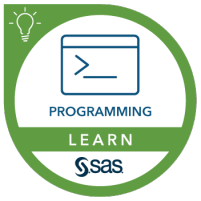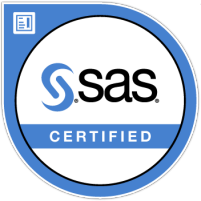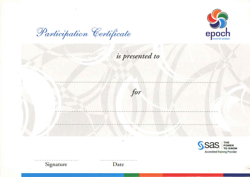- Home
- Advanced SAS Programmer Certification
Advanced SAS Programmer Certification
Represents the upper echelon of SAS® programmers who demonstrate a high level of proficiency in SAS® programming expertise
Power up your staff’s skills and boost your business
Course Description
This course is for SAS programmers who prepare data for analysis. The comparisons of manipulation techniques and resource cost benefits are designed to help programmers choose the most appropriate technique for their data situation. It focuses on the components of the SAS macro facility and how to design, write, and debug macro systems. Emphasis is placed on understanding how programs with and without macro code are processed. It also covers how to process SAS data using Structured Query Language (SQL).This course helps you prepare you for the following certification exam(s): SAS Certified Advanced Programmer for SAS 9.
About Program
Successful candidates should be skilled in tasks such as:
- Using advanced DATA step programming statements and efficiency techniques to solve complex problems.
- Writing and interpreting SAS SQL code.
- Creating and using the SAS MACRO facility.
Candidates who earn this credential must have a SAS Certified Base Programmer for SAS®9 credential and then take and pass the SAS Advanced Programming for SAS®9 exam.
Prerequisite
Before attending this course, you should have experience using computer software. Specifically, you should be able to
- Read raw data files and SAS data sets
- Investigate and summarize data by generating frequency tables and descriptive statistics
- Create SAS variables and recode data values
- Subset data
- Combine multiple SAS files
- Create listing, summary, HTML, and graph reports.
Course Curriculum
Introduction
- course logistics
- purpose of the macro facility
- program flow
Macro Variables
- introduction to macro variables
- automatic macro variables
- macro variable references
- user-defined macro variables
- delimiting macro variable references
- macro functions
Macro Definitions
- defining and calling a macro
- macro parameters
DATA Step and SQL Interfaces
- creating macro variables in the DATA step
- indirect references to macro variables
- creating macro variables in SQL
Macro Programs
- conditional processing
- parameter validation
- iterative processing
- global and local symbol tables
Learning More
- SAS resources
- beyond this course
Supplemental Materials
- program flow
Introduction
- overview of SAS Foundation
- course logistics
- course data files
- introducing the Structured Query Language
Basic Queries
- overview of the SQL procedure
- specifying columns
- specifying rows
Displaying Query Results
- presenting data
- summarizing data
SQL Joins
- introduction to SQL joins
- inner joins
- outer joins
- complex SQL joins
Set Operators
- introduction to set operators
- the UNION operator
- the OUTER UNION operator
- the EXCEPT operator
- the INTERSECT operator
Creating Tables and Views
- creating tables with the SQL procedure
- creating views with the SQL procedure
Advanced PROC SQL Features
- dictionary tables and views
- using SQL procedure options
- interfacing PROC SQL with the macro language
Subqueries
- noncorrelated subqueries
- in-line views
Learning More
- SAS resources
- beyond this course
Introduction
- course logistics
- creating course data files
Efficient SAS Programming
- identifying computer resources related to efficiency
Controlling I/O Processing and Memory
- SAS DATA step processing
- controlling I/O
- reducing the length of numeric variables
- compressing SAS data sets
- using SAS views
Accessing Observations
- access methods
- accessing observations by number
- creating an index
- using an index
DATA Step Arrays
- introduction to lookup techniques
- one-dimensional arrays
- multidimensional arrays
- loading a multidimensional array from a SAS data set
DATA Step Hash and Hiter Objects
- hash object methods
- loading a hash object from a SAS data set
- DATA step hiter object
Combining Data Horizontally
- DATA step merges and SQL procedure joins
- using an index to combine data
- combining summary and detail data
- combining data conditionally
User-Defined Functions and Formats
- user-defined functions
- user-defined formats
Learning More
- areas of support from SAS
- other courses to consider
Certificate
Digital Badges



 Course Description
Course Description About Program
About Program Prerequisite
Prerequisite Course Curriculum
Course Curriculum Certificate
Certificate Digital Badges
Digital Badges Course Fees
Course Fees

 Watch
Watch Contact
Contact

 Find My Path
Find My Path